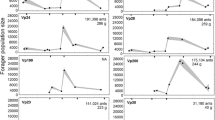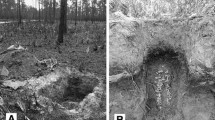Summary
Colony size and worker polymorphism (headwidth) were determined for fire ant colonies ranging from incipient to 12 years of age. Colonies grew approximately logistically, reaching half size between 21/2 and 31/2 yr and reaching their maximum size of about 220000 workers after 4 to 6 yr. Colony size showed strong seasonal variation. There was some evidence that growth rate may vary with food density. Incipient colonies are monomorphic and consist of small workers only, but as colonies grow, production of larger workers causes the size-frequency distributions to become strongly skewed. These skewed distributions were shown to consist of two slightly overlapping normal distributions, a narrow one defined as the minor workers, and a much broader one defined as the major workers. Major workers differ from minor workers in having been subjected to a discrete, additional stimulation of body growth, resulting in a second normal subpopulation. The category of “media” is seen to be developmentally undefined. The mean headwidth of the workers in both of these subpopulations increased during the first 6 mo. of colony life, until colonies averaged about 4000 workers. Headwidth of minors declined somewhat in colonies older than about 5 yr, but that of majors remained stable. When the first majors appear, their weight averages about twice that of minors. This increases to about 4 times at 6 mo. and remains stable thereafter. The range of weights of majors is up to 20 times that of minors. Growth of the subpopulation of major workers is also logistic, but more rapid than the colony as a whole, causing the proportion of major workers to increase with colony size. In full sized colonies, about 35% of the workers are majors. Total biomass investment in majors increases as long as colonies grow, beginning at about 10% at 2 months and reaching about 70% in mature colonies. This suggests that major workers play an important role in colony success. The total dry biomass of workers peaked at about 106 g, that of majors at about 72 g. These values then fluctuate seasonally in parallel to number of workers. When colony growth ceases, the proportion of majors remains approximately stable. Colony size explained 98% of the variation in the number of major workers.
Similar content being viewed by others
References
Bernstein RS (1980) Morphological variability of ants on and around Devil's Tower. Am Midl Nat 104:185–188
Bodenheimer FS (1937) Population problems of social insects. Biol Rev 12:393–430
Brian MV (1956) Group form and the causes of working inefficiency in the ant Myrmica rubra L. Physiol Zool 29:173–194
Brian MV (1957a) The growth and development of colonies of the ant Myrmica. Insect Soc 4:177–190
Brian MV (1957b) Food distribution and larval size in cultures of the ant Myrmica rubra (L.). Physiol Comp Oecol 4:329–345
Brian MV (1965) Social insect populations. Academic Press, New York, NY
Busher CE, Calabi P, Traniello JFA (1985) Polymorphism and division of labor in the neotropical ant Camponotus sericeiventris Guerin (Hymenoptera: Formicidae). Ann Entomol Soc Am 78:221–228
Corn ML (1980) Polymorphism and polyethism in the neotropical ant Cephalotes atratus (L.). Insec Soc 27:29–42
Davidson DD (1978) Size variability in the worker caste of a social insect (Veromessor pergandei Mayr) as a function of the competitive environment. Am Nat 112:523–532
Evesham EJM (1985) The interaction of food distribution and the caste composition of an ant colony (Myrmica rubra L.). J Zool (Lond) 207:241–250
Gray B (1971) A morphometric study of the ant species, Myrmecia dispar (Clark). Insec Soc 18:95–110
Greenberg L, Fletcher DJC, Vinson SB (1985) Differences in worker size and mound distribution in monogynous and polygynous colonies of the fire ant Solenopsis invicta Buren. J Kan Entomol Soc 58:9–18
Johnston AB, Wilson EO (1985) Correlates of variation in the major/minor ratio of the ant Pheidole dentata (Hymenoptera Formicidae). Ann Entomol Soc Am 78:8–11
Jonkman JCM (1980) The external and internal structure and growth of nests of the leafcutting ant Atta vollenweideri Forel, 1983. Z Ang Ent 89:158–173
Kondoh M (1968) Bionomic studies on the colony of an ant species, Formica japonica Motsch. 2. Allometric study of the body weight and the corpulency relating to the body size of workers. J Jap Ecol 18:171–179
Leutert W (1962) Beitrag zur Kenntnis des Polymorphismus bei Campanotus ligniperda Latr. Mitt Schweiz Entom Gesell 35:146–154
Markin GP, Collins HL, Dillier JH (1972) Colony founding by queens of the red imported fire ant, Solenopsis invicta. Ann Entomol Soc Am 65:1053–1058
Markin GP, Dillier JH (1971) The seasonal life cycle of the imported fire ant, Solenopsis saevissima richteri, on the Gulf Coast of Mississippi. Ann Entomol Soc Am 64:562–565
Markin GP, Dillier JH, Collins HL (1973) Growth and development of colonies of the red imported fire ant, Solenopsis invicta. Ann Entomol Soc Am 66:803–808
Michener CD (1964) Reproductive efficiency in relation to colony size in hymenopterous societies. Insect Soc 11:317–342
Morrill WL (1974) Production and flight of alate red imported fire ants. Envir Entomol 3:265–271
Oster GF, Wilson EO (1978) Caste and Ecology in the Social Insects. Princeton, New Jersey, NJ
Pisarski B (1981) Intraspecific variations in ants of the genus Formica L. In: (Howse PE, Clement JC, eds) Biosystematics of social insects. Academic Press, London, New York, pp 17–25
Porter SD (1983) Fast, accurate method of measuring ant head-widths. Ann Entomol Soc Am 76:866–867
Porter SD, Tschinkel WR (1985a) Fire ant polymorphism: the ergonomics of brood production. Behav Ecol Sociobiol 16:323–336
Porter SD, Tschinkel WR (1985b) Fire ant polymorphism: factors affecting worker size. Ann Entomol Soc Am 78:381–386
Porter SD, Tschinkel WR (1986) Adaptive value of nanitic workers in newly founded red imported fire ant colonies (Hymenoptera: Formicidae). Ann Entomol Soc Am 79:723–726
Rissing SW (1987) Annual cycles in worker size of the seed-harvester ant Veromessor pergandei (Hymenoptera: Formicidae). Behav Ecol Sociobiol 20:117–124
Rissing SW, Pollock GB (1986) Social interaction among pleometrotic queens of Veromessor pergandei (Hymenoptera: Formicidae) during colony foundation. Anim Behav 34:226–233
Ryan TA, Joiner BL, Ryan BF (1982) Minitab reference manual. Duxbury Press, Boston
Topoff H (1971) Polymorphism in army ants related to division of labor and colony cyclic behavior. Am Nat 105:529–548
Tschinkel WR (1988) Social control of egg-laying rate in queens of the fire ant, Solenopsis invicta. Physiol Entomol (in press)
Tschinkel WR, Howard DF (1983) Colony founding by pleometrosis in the fire ant Solenopsis invicta. Behav Ecol Sociobiol 12:103–113
Tschinkel WR, Porter SD (1988) The efficiency of sperm use in queens of the fire ant, Solenopsis invicta. Ann Entomol Soc Am (in press)
Weber NA (1982) Fungus ants. In: Hermann HR (ed) Social insects, vol 4. Academic Press, London New York, pp 255–357
Wheeler DE (1986) Developmental and physiological determinants of caste in social hymenoptera: evolutionary implications. Am Nat 128:13–34
Wheeler DE, Nijhout HF (1981) Soldier determination in ants: new role for juvenile hormone. Science 213:361–363
Wheeler WM (1910) Ants: their structure and development. Columbia University Press, New York, NY
Wilson EO (1971) The insect societies, Harvard Press, Cambridge, MA
Wilson EO (1978) Division of labor in fire ants based on physical castes (Hymenoptera: Formicidae: Solenopsis). J Kan Entomol Soc 51:615–636
Wilson EO (1983) Caste and division of labor in leaf-cutter ants (Hymenoptera: Formicidae: Atta). IV. Colony ontogeny of A. cephalotes. Behav Ecol Sociobiol 14:55–60
Wilson EO (1984) The relation between caste ratios and division of labor in the ant genus Pheidole (Hymenoptera: Formicidae). Behav Ecol Sociobiol 16:89–98
Wilson NL, Dillier JH, Markin GP (1971) Foraging territories of imported fire ants. Ann Entomol Soc Am 64:660–665
Wood LA, Tschinkel WR (1981) Quantification and modification of worker size variation in the fire ant, Solenopsis invicta. Insectes Sociaux 28:117–128
Author information
Authors and Affiliations
Additional information
This is paper No. 18 of the Fire Ant Research Team
Rights and permissions
About this article
Cite this article
Tschinkel, W.R. Colony growth and the ontogeny of worker polymorphism in the fire ant, Solenopsis invicta . Behav Ecol Sociobiol 22, 103–115 (1988). https://doi.org/10.1007/BF00303545
Received:
Accepted:
Issue Date:
DOI: https://doi.org/10.1007/BF00303545




